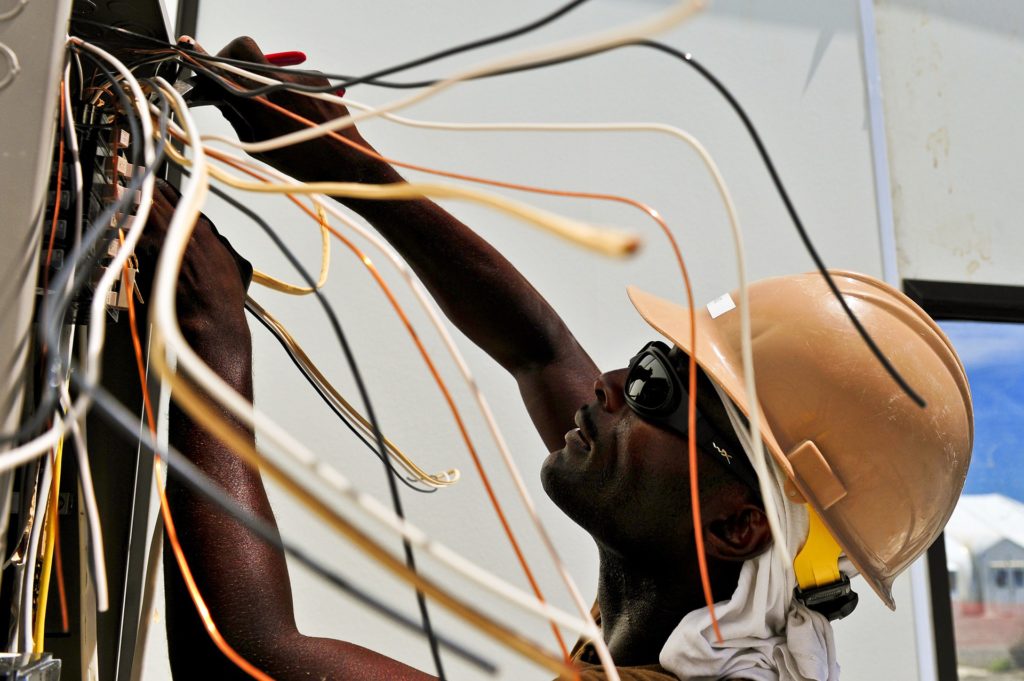 According to the Occupational Safety and Health Administration (OSHA), wiring issues that result in electrical shocks are among the most common and deadly standards violations. While not as frequently deadly as falls from roofs or ladders, electrical shocks are especially dangerous since they are not always easy to detect. In movies and TV shows, we see visual representations of electrical hazards as loose wires sparking violently or glowing bolts of electricity spread throughout pools of water.
According to the Occupational Safety and Health Administration (OSHA), wiring issues that result in electrical shocks are among the most common and deadly standards violations. While not as frequently deadly as falls from roofs or ladders, electrical shocks are especially dangerous since they are not always easy to detect. In movies and TV shows, we see visual representations of electrical hazards as loose wires sparking violently or glowing bolts of electricity spread throughout pools of water.
In reality, however, these kinds of hazards are invisible. A frayed wire might not reveal any danger beyond its ragged appearance until someone touches it with a bare hand and an electrical current suddenly surges through his body.
In order to avoid shock hazards at a work site, electrical wires must be properly maintained and shielded. Temporary cables and wires need to be in good condition, protected from damage, and used for a short period of time. Also, wiring cannot be installed in certain locations like ducts and ventilation for commercial cooking equipment.
General Electrical Safety
Construction workers and their employers are responsible for making sure general safety standards are met. This includes steps like shutting off all power before working on new or existing electrical circuits (also called lockout). Frayed or damaged cords and wires must be promptly replaced, and extension cords need to have grounding prongs to ensure they are used safely.
Construction companies need to instill the importance of safe habits in their workers, including routinely inspecting and replacing powered equipment when damaged or worn down. Protective systems should never be bypassed by any workers at a construction site, and everyone at such a site needs to be aware of overhead and underground power lines. These power lines can cause serious injuries and fatalities if ladders, scaffolds, and other equipment are not kept at least 10 feet from them at all times.
What Can Electricity Do to a Person?
When an electric current contacts the human body, the effects depend on the size of the current, measured in milliamperes. These include:
- 1 milliampere: A faint tingling sensation; anything below this amount is usually not noticeable.
- 5 milliamperes: Slight shock, though not particularly painful.
- 6-25 milliamperes (women): Painful shock; often includes a loss of muscle control.
- 9-30 milliamperes (men): Painful shock; most people cannot let go of the wire but may be thrown away from the source of shock.
- 50-150 milliamperes: Extremely painful shock; often includes severe muscle contractions and difficulty breathing. Possibly fatal.
- 1,000-4,300 milliamperes: Heartbeat ceases; muscular contractions are common as is nerve damage. Likely to be fatal.
- 10,000+ milliamperes: Cardiac arrest occurs; severe burns to the body and nerve damage. Probably fatal.
Who Is Most at Risk of Electrocution Death?
It should come as little surprise that the workers most at risk of death from electrocution are electrical workers, according to data from the Center for Construction Research and Training. Of the 1,715 electrocution deaths among construction workers from 1992-2003, 34% were electrical workers. Second to this were general construction laborers, who accounted for 16% of deaths.
Data from 2008-2010 supports this as an ongoing trend: in that time there were 252 deaths due to electrocution. Of those, 69 of them, or about 27%, were electricians; and 41, or about 16%, were general laborers. That does show a decline in the percentage of electricians among those who died from electrocution deaths (and the numbers in general have been on the decline over the past couple decades), but it is still a serious hazard.
Major Causes of Electrocution Fatalities
The most common causes of electrocution deaths depend on whether someone is a professional electrical worker or a construction worker in a different field. For electrical workers:
- 58% caused by electrical wiring and equipment
- 34% caused by overhead power lines
- 4% caused by machinery and appliances
- 3% from other causes
For other construction workers:
- 56% caused by overhead power lines
- 24% caused by electrical wiring and equipment
- 11% caused by machinery and appliances
- 9% from other causes
Power lines, wiring, and electrical equipment together pose the greatest risk to all workers. A failure to communicate the state of a piece of equipment or wiring at a construction site is often the underlying cause of serious shock or burn injuries in these cases.
If you were not warned by lockout or tagout that a machine or wire was live on a job site and suffered injury, speak to our New York electrical accident lawyers at Wingate, Russotti, Shapiro, Moses & Halperin, LLP. We have handled hundreds of similar cases for construction workers to get them the compensation they needed to recover and move on with their lives. For a free consultation about your case, call (212) 986-7353.